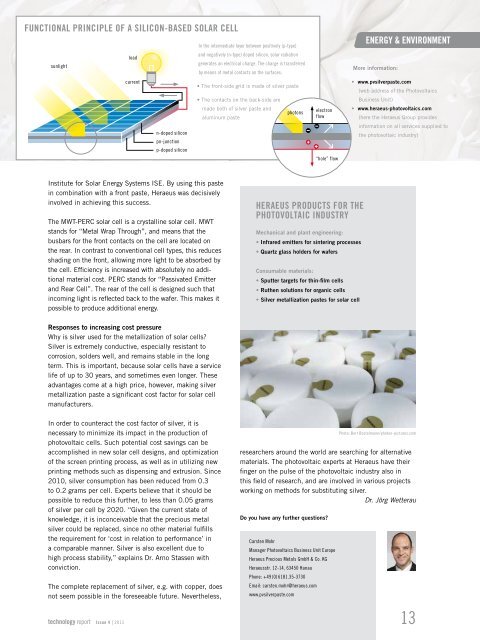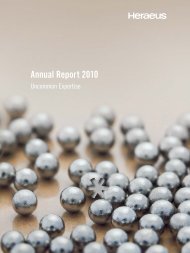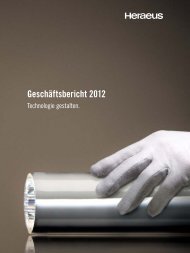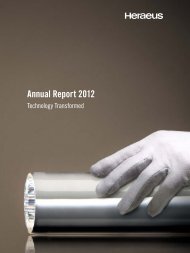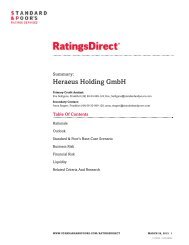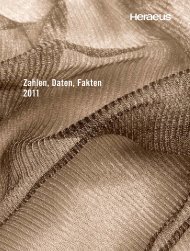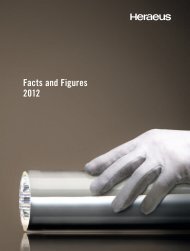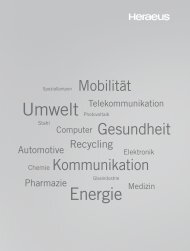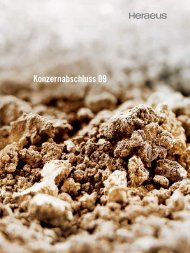technology report 04
technology report 04
technology report 04
Create successful ePaper yourself
Turn your PDF publications into a flip-book with our unique Google optimized e-Paper software.
Functional principle of a silicon-based solar cell<br />
In the intermediate layer between positively (p-type)<br />
and negatively (n-type) doped silicon, solar radiation<br />
load<br />
generates an electrical charge. The charge is transferred<br />
sunlight<br />
by means of metal contacts on the surfaces:<br />
current<br />
• The front-side grid is made of silver paste<br />
• The contacts on the back-side are<br />
made both of silver paste and<br />
photons<br />
aluminum paste<br />
n-doped silicon<br />
pn-junction<br />
p-doped silicon<br />
electron<br />
flow<br />
“hole” flow<br />
ENERGY & ENVIRONMENT<br />
More information:<br />
• www.pvsilverpaste.com<br />
(web address of the Photovoltaics<br />
Business Unit)<br />
• www.heraeus-photovoltaics.com<br />
(here the Heraeus Group provides<br />
information on all services supplied to<br />
the photovoltaic industry)<br />
Institute for Solar Energy Systems ISE. By using this paste<br />
in combination with a front paste, Heraeus was decisively<br />
involved in achieving this success.<br />
The MWT-PERC solar cell is a crystalline solar cell. MWT<br />
stands for “Metal Wrap Through”, and means that the<br />
busbars for the front contacts on the cell are located on<br />
the rear. In contrast to conventional cell types, this reduces<br />
shading on the front, allowing more light to be absorbed by<br />
the cell. Efficiency is increased with absolutely no additional<br />
material cost. PERC stands for “Passivated Emitter<br />
and Rear Cell”. The rear of the cell is designed such that<br />
incoming light is reflected back to the wafer. This makes it<br />
possible to produce additional energy.<br />
Heraeus products for the<br />
photovoltaic industry<br />
Mechanical and plant engineering:<br />
• Infrared emitters for sintering processes<br />
• Quartz glass holders for wafers<br />
Consumable materials:<br />
• Sputter targets for thin-film cells<br />
• Ruthen solutions for organic cells<br />
• Silver metallization pastes for solar cell<br />
Responses to increasing cost pressure<br />
Why is silver used for the metallization of solar cells?<br />
Silver is extremely conductive, especially resistant to<br />
corrosion, solders well, and remains stable in the long<br />
term. This is important, because solar cells have a service<br />
life of up to 30 years, and sometimes even longer. These<br />
advantages come at a high price, however, making silver<br />
metallization paste a significant cost factor for solar cell<br />
manufacturers.<br />
In order to counteract the cost factor of silver, it is<br />
necessary to minimize its impact in the production of<br />
photovoltaic cells. Such potential cost savings can be<br />
accomplished in new solar cell designs, and optimization<br />
of the screen printing process, as well as in utilizing new<br />
printing methods such as dispensing and extrusion. Since<br />
2010, silver consumption has been reduced from 0.3<br />
to 0.2 grams per cell. Experts believe that it should be<br />
possible to reduce this further, to less than 0.05 grams<br />
of silver per cell by 2020. “Given the current state of<br />
knowledge, it is inconceivable that the precious metal<br />
silver could be replaced, since no other material fulfills<br />
the requirement for ‘cost in relation to performance’ in<br />
a comparable manner. Silver is also excellent due to<br />
high process stability,” explains Dr. Arno Stassen with<br />
conviction.<br />
The complete replacement of silver, e.g. with copper, does<br />
not seem possible in the foreseeable future. Nevertheless,<br />
<strong>technology</strong> <strong>report</strong> Issue 4 | 2013<br />
researchers around the world are searching for alternative<br />
materials. The photovoltaic experts at Heraeus have their<br />
finger on the pulse of the photovoltaic industry also in<br />
this field of research, and are involved in various projects<br />
working on methods for substituting silver.<br />
Dr. Jörg Wetterau<br />
Do you have any further questions?<br />
Carsten Mohr<br />
Manager Photovoltaics Business Unit Europe<br />
Heraeus Precious Metals GmbH & Co. KG<br />
Heraeusstr. 12-14, 63450 Hanau<br />
Phone: +49(0)6181.35-3730<br />
Email: carsten.mohr@heraeus.com<br />
www.pvsilverpaste.com<br />
Photo: Bert Bostelmann/photon-pictures.com<br />
13


